Comprehensive Guide to Risk Management Strategies and Applications
VerifiedAdded on 2022/01/24
|42
|7066
|175
Report
AI Summary
This report provides a detailed overview of risk management strategies, which are crucial for businesses to effectively handle potential risks. It defines a risk management strategy as a structured approach to address risks, emphasizing that it's a cyclical process involving identification, assessment, management, and monitoring of risks. The report outlines four main strategies: risk acceptance (taking no action), risk transference (shifting responsibility), risk avoidance (eliminating the risk), and risk reduction (minimizing the impact). It explains each strategy with examples, highlighting the importance of choosing the appropriate approach based on the specific risk. The report also underscores the importance of a robust risk management strategy for operational effectiveness, asset protection, customer satisfaction, goal achievement, and profitability. Moreover, it emphasizes the need for companies to proactively identify, assess, and manage risks to ensure business continuity and success. The report also touches on the importance of risk monitoring to address new or escalating risks.
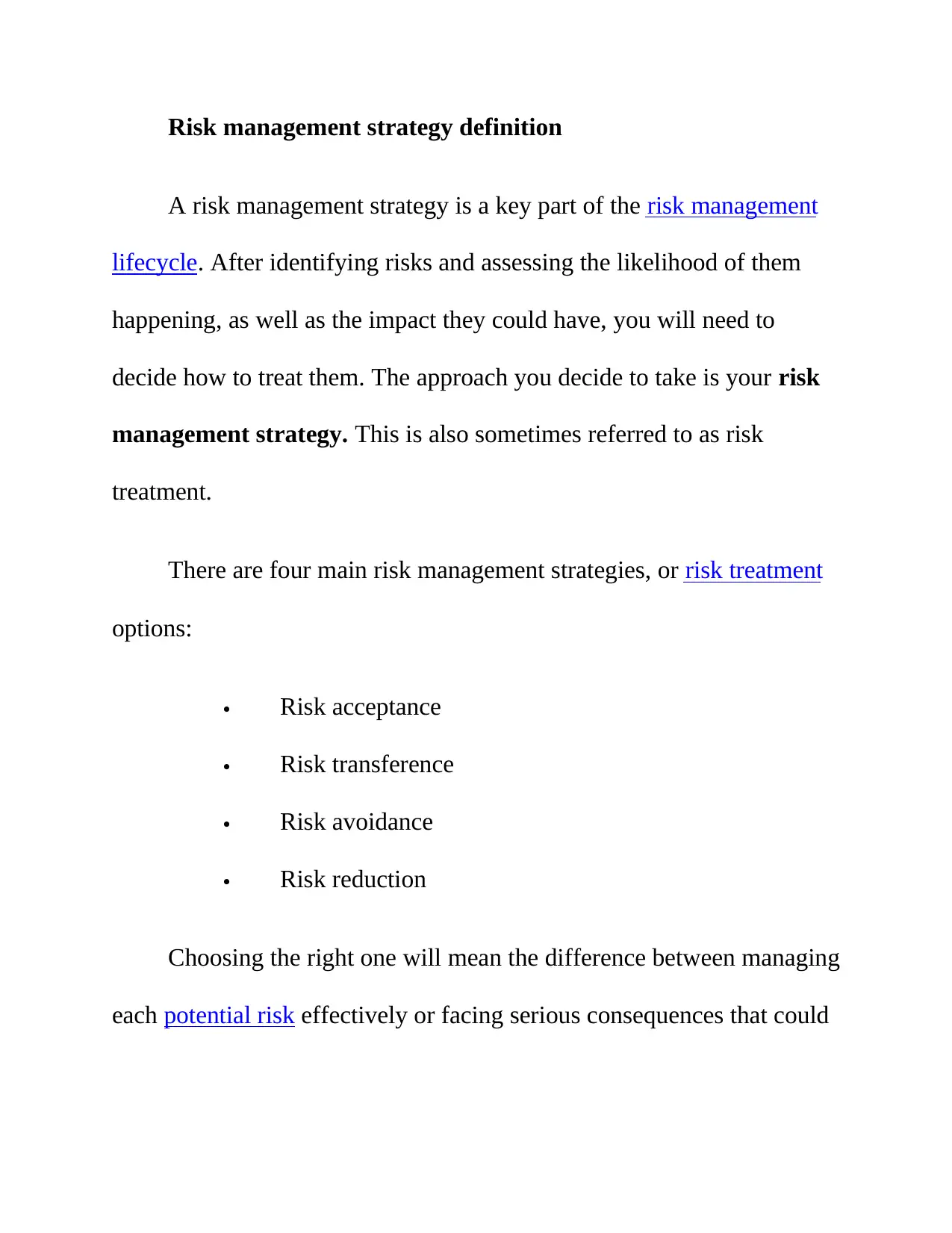
Risk management strategy definition
A risk management strategy is a key part of the risk management
lifecycle. After identifying risks and assessing the likelihood of them
happening, as well as the impact they could have, you will need to
decide how to treat them. The approach you decide to take is your risk
management strategy. This is also sometimes referred to as risk
treatment.
There are four main risk management strategies, or risk treatment
options:
Risk acceptance
Risk transference
Risk avoidance
Risk reduction
Choosing the right one will mean the difference between managing
each potential risk effectively or facing serious consequences that could
A risk management strategy is a key part of the risk management
lifecycle. After identifying risks and assessing the likelihood of them
happening, as well as the impact they could have, you will need to
decide how to treat them. The approach you decide to take is your risk
management strategy. This is also sometimes referred to as risk
treatment.
There are four main risk management strategies, or risk treatment
options:
Risk acceptance
Risk transference
Risk avoidance
Risk reduction
Choosing the right one will mean the difference between managing
each potential risk effectively or facing serious consequences that could
Paraphrase This Document
Need a fresh take? Get an instant paraphrase of this document with our AI Paraphraser
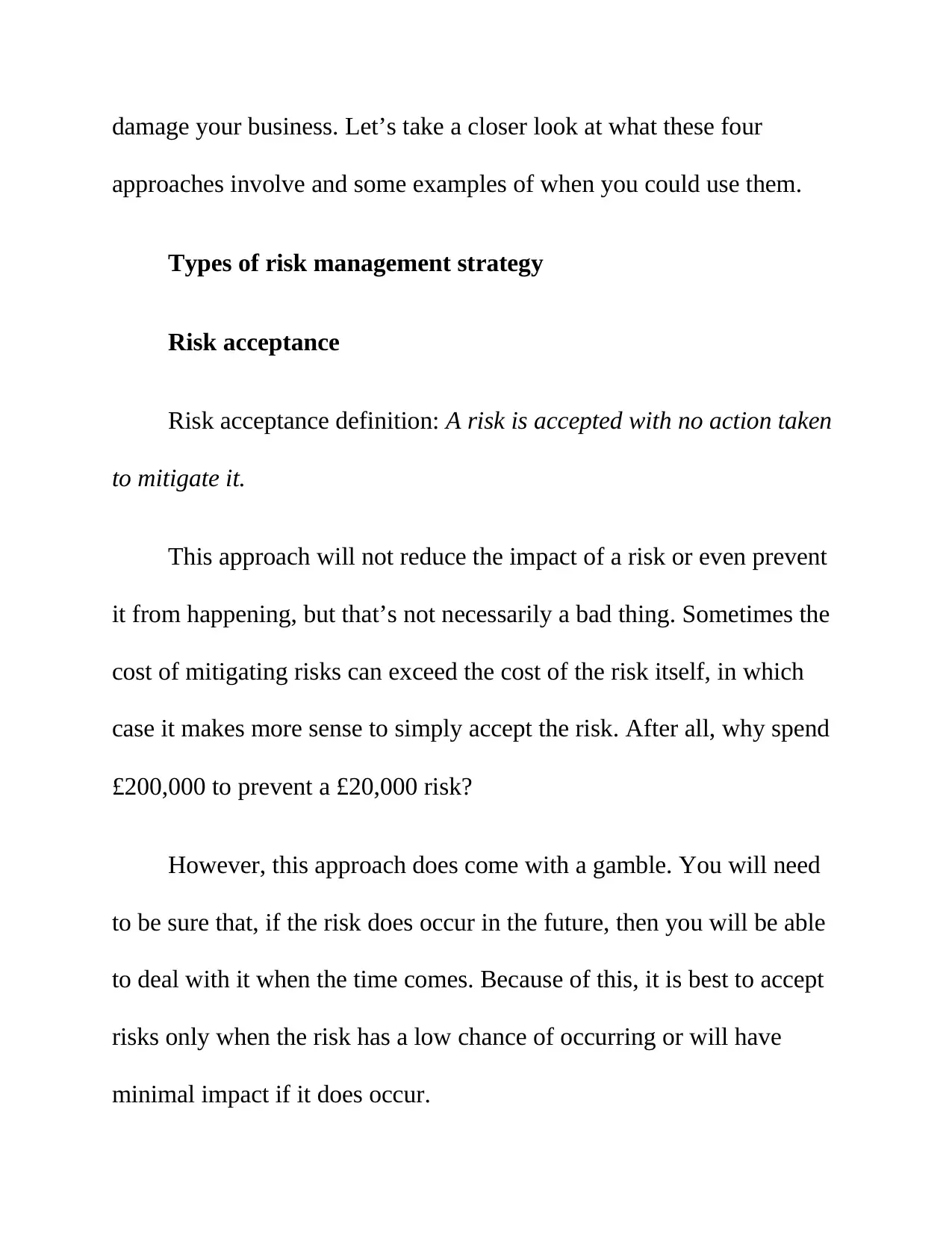
damage your business. Let’s take a closer look at what these four
approaches involve and some examples of when you could use them.
Types of risk management strategy
Risk acceptance
Risk acceptance definition: A risk is accepted with no action taken
to mitigate it.
This approach will not reduce the impact of a risk or even prevent
it from happening, but that’s not necessarily a bad thing. Sometimes the
cost of mitigating risks can exceed the cost of the risk itself, in which
case it makes more sense to simply accept the risk. After all, why spend
£200,000 to prevent a £20,000 risk?
However, this approach does come with a gamble. You will need
to be sure that, if the risk does occur in the future, then you will be able
to deal with it when the time comes. Because of this, it is best to accept
risks only when the risk has a low chance of occurring or will have
minimal impact if it does occur.
approaches involve and some examples of when you could use them.
Types of risk management strategy
Risk acceptance
Risk acceptance definition: A risk is accepted with no action taken
to mitigate it.
This approach will not reduce the impact of a risk or even prevent
it from happening, but that’s not necessarily a bad thing. Sometimes the
cost of mitigating risks can exceed the cost of the risk itself, in which
case it makes more sense to simply accept the risk. After all, why spend
£200,000 to prevent a £20,000 risk?
However, this approach does come with a gamble. You will need
to be sure that, if the risk does occur in the future, then you will be able
to deal with it when the time comes. Because of this, it is best to accept
risks only when the risk has a low chance of occurring or will have
minimal impact if it does occur.
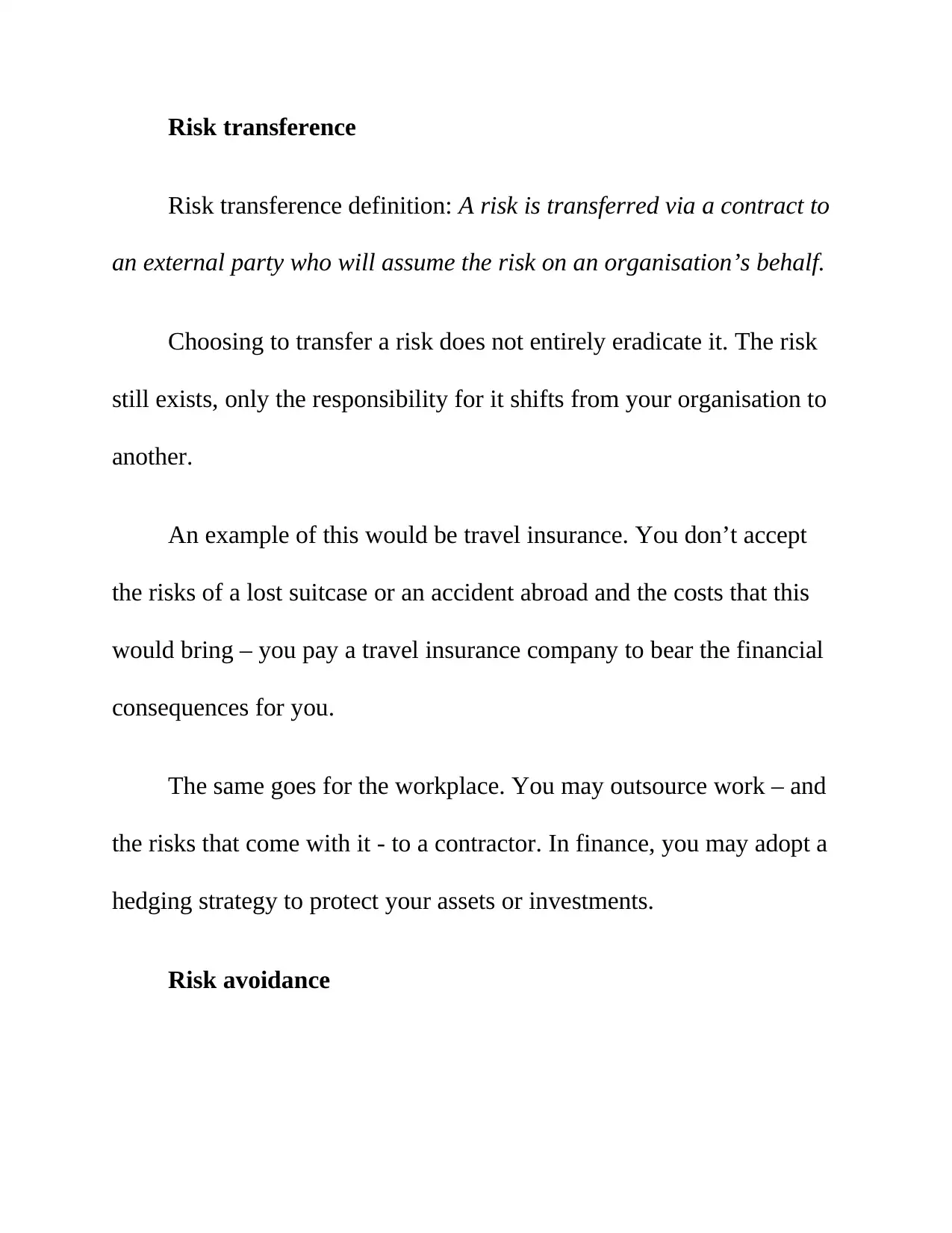
Risk transference
Risk transference definition: A risk is transferred via a contract to
an external party who will assume the risk on an organisation’s behalf.
Choosing to transfer a risk does not entirely eradicate it. The risk
still exists, only the responsibility for it shifts from your organisation to
another.
An example of this would be travel insurance. You don’t accept
the risks of a lost suitcase or an accident abroad and the costs that this
would bring – you pay a travel insurance company to bear the financial
consequences for you.
The same goes for the workplace. You may outsource work – and
the risks that come with it - to a contractor. In finance, you may adopt a
hedging strategy to protect your assets or investments.
Risk avoidance
Risk transference definition: A risk is transferred via a contract to
an external party who will assume the risk on an organisation’s behalf.
Choosing to transfer a risk does not entirely eradicate it. The risk
still exists, only the responsibility for it shifts from your organisation to
another.
An example of this would be travel insurance. You don’t accept
the risks of a lost suitcase or an accident abroad and the costs that this
would bring – you pay a travel insurance company to bear the financial
consequences for you.
The same goes for the workplace. You may outsource work – and
the risks that come with it - to a contractor. In finance, you may adopt a
hedging strategy to protect your assets or investments.
Risk avoidance
⊘ This is a preview!⊘
Do you want full access?
Subscribe today to unlock all pages.

Trusted by 1+ million students worldwide
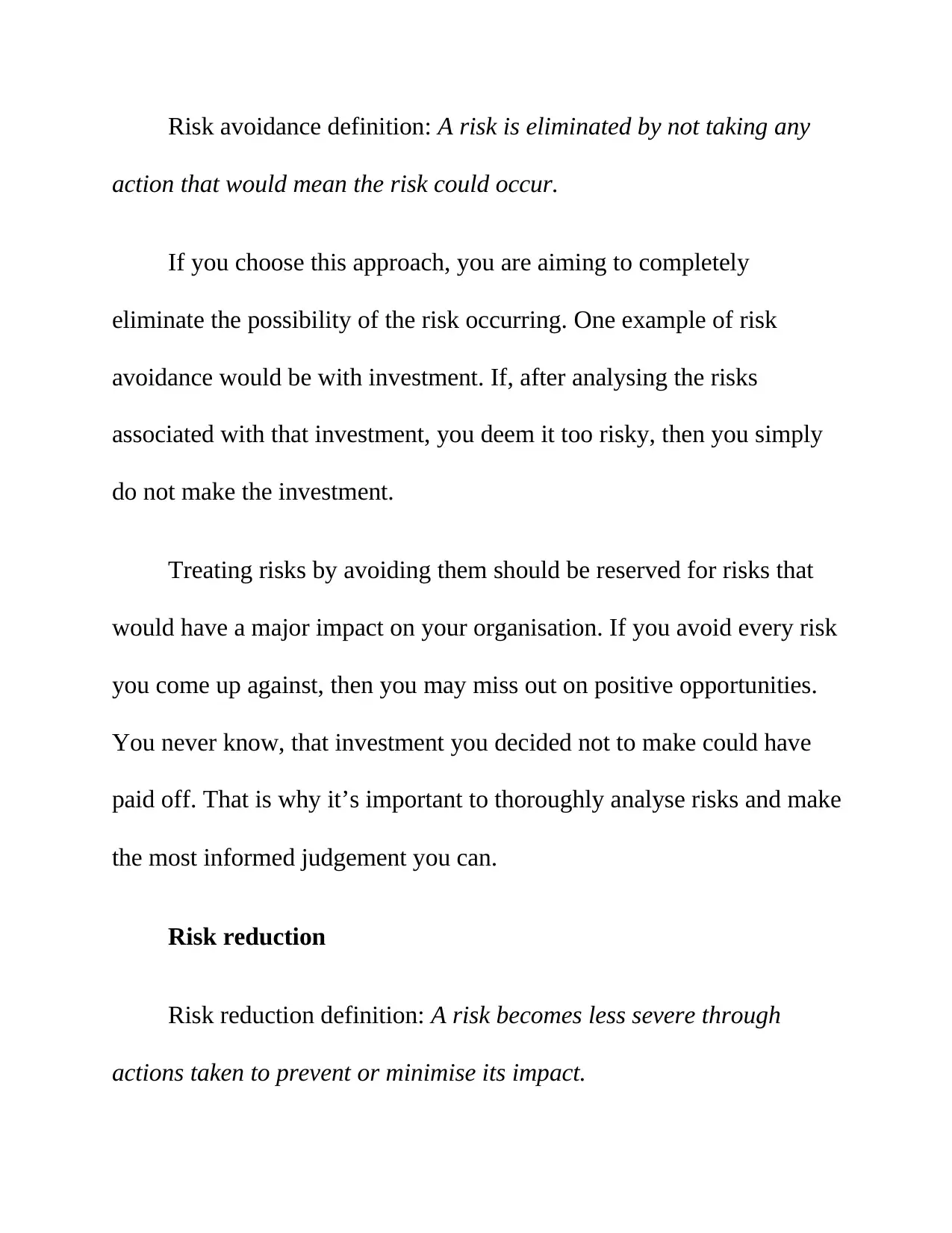
Risk avoidance definition: A risk is eliminated by not taking any
action that would mean the risk could occur.
If you choose this approach, you are aiming to completely
eliminate the possibility of the risk occurring. One example of risk
avoidance would be with investment. If, after analysing the risks
associated with that investment, you deem it too risky, then you simply
do not make the investment.
Treating risks by avoiding them should be reserved for risks that
would have a major impact on your organisation. If you avoid every risk
you come up against, then you may miss out on positive opportunities.
You never know, that investment you decided not to make could have
paid off. That is why it’s important to thoroughly analyse risks and make
the most informed judgement you can.
Risk reduction
Risk reduction definition: A risk becomes less severe through
actions taken to prevent or minimise its impact.
action that would mean the risk could occur.
If you choose this approach, you are aiming to completely
eliminate the possibility of the risk occurring. One example of risk
avoidance would be with investment. If, after analysing the risks
associated with that investment, you deem it too risky, then you simply
do not make the investment.
Treating risks by avoiding them should be reserved for risks that
would have a major impact on your organisation. If you avoid every risk
you come up against, then you may miss out on positive opportunities.
You never know, that investment you decided not to make could have
paid off. That is why it’s important to thoroughly analyse risks and make
the most informed judgement you can.
Risk reduction
Risk reduction definition: A risk becomes less severe through
actions taken to prevent or minimise its impact.
Paraphrase This Document
Need a fresh take? Get an instant paraphrase of this document with our AI Paraphraser
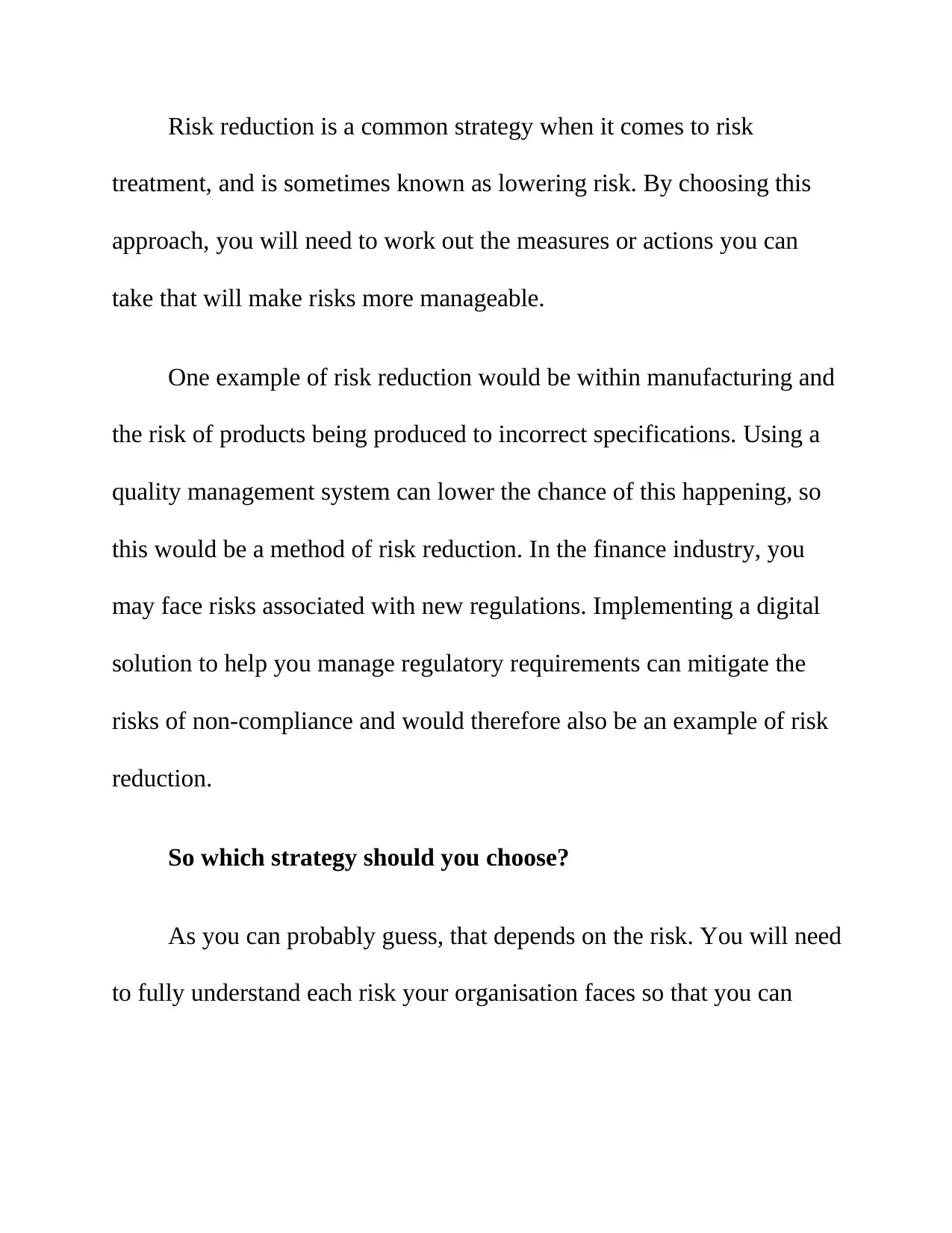
Risk reduction is a common strategy when it comes to risk
treatment, and is sometimes known as lowering risk. By choosing this
approach, you will need to work out the measures or actions you can
take that will make risks more manageable.
One example of risk reduction would be within manufacturing and
the risk of products being produced to incorrect specifications. Using a
quality management system can lower the chance of this happening, so
this would be a method of risk reduction. In the finance industry, you
may face risks associated with new regulations. Implementing a digital
solution to help you manage regulatory requirements can mitigate the
risks of non-compliance and would therefore also be an example of risk
reduction.
So which strategy should you choose?
As you can probably guess, that depends on the risk. You will need
to fully understand each risk your organisation faces so that you can
treatment, and is sometimes known as lowering risk. By choosing this
approach, you will need to work out the measures or actions you can
take that will make risks more manageable.
One example of risk reduction would be within manufacturing and
the risk of products being produced to incorrect specifications. Using a
quality management system can lower the chance of this happening, so
this would be a method of risk reduction. In the finance industry, you
may face risks associated with new regulations. Implementing a digital
solution to help you manage regulatory requirements can mitigate the
risks of non-compliance and would therefore also be an example of risk
reduction.
So which strategy should you choose?
As you can probably guess, that depends on the risk. You will need
to fully understand each risk your organisation faces so that you can
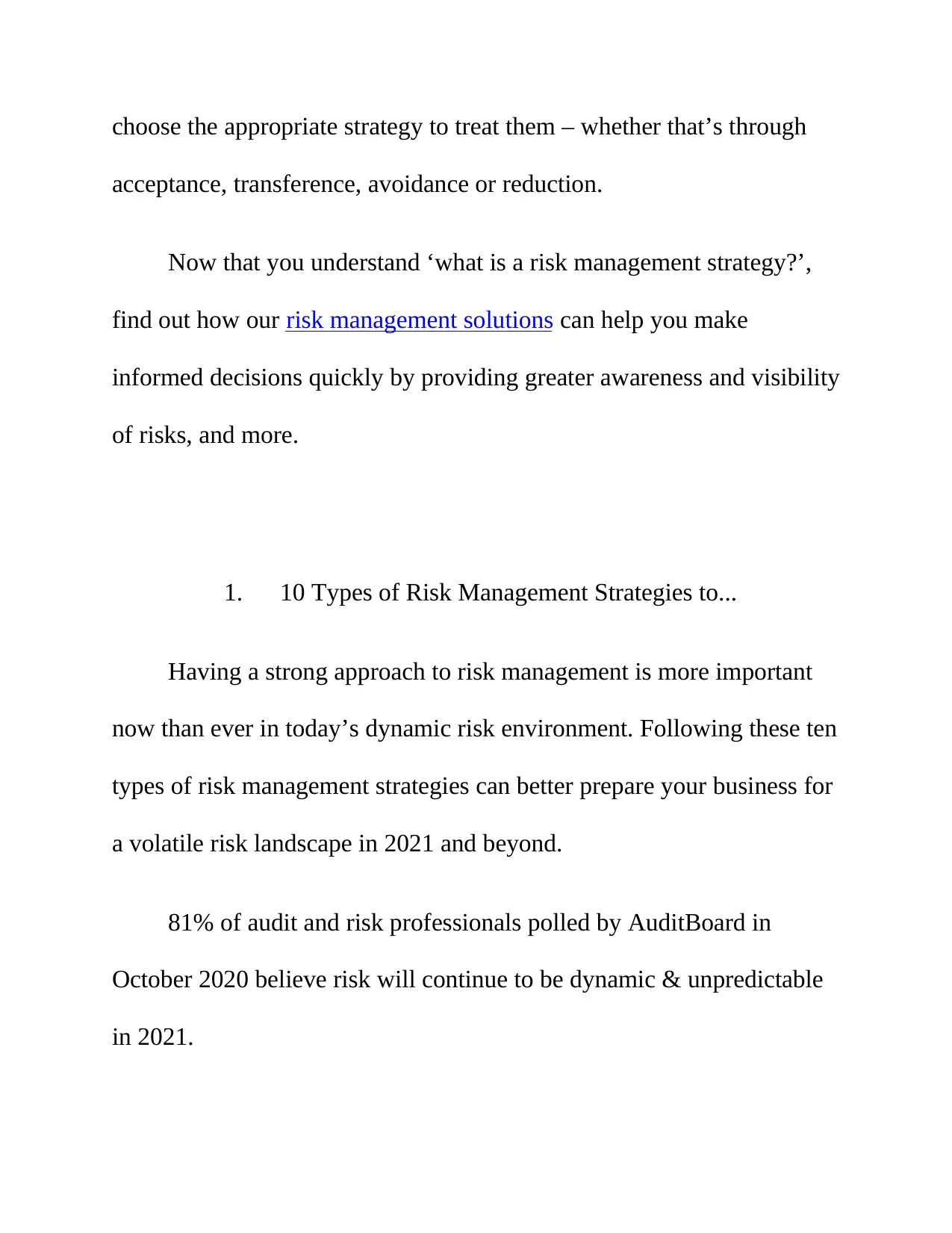
choose the appropriate strategy to treat them – whether that’s through
acceptance, transference, avoidance or reduction.
Now that you understand ‘what is a risk management strategy?’,
find out how our risk management solutions can help you make
informed decisions quickly by providing greater awareness and visibility
of risks, and more.
1. 10 Types of Risk Management Strategies to...
Having a strong approach to risk management is more important
now than ever in today’s dynamic risk environment. Following these ten
types of risk management strategies can better prepare your business for
a volatile risk landscape in 2021 and beyond.
81% of audit and risk professionals polled by AuditBoard in
October 2020 believe risk will continue to be dynamic & unpredictable
in 2021.
acceptance, transference, avoidance or reduction.
Now that you understand ‘what is a risk management strategy?’,
find out how our risk management solutions can help you make
informed decisions quickly by providing greater awareness and visibility
of risks, and more.
1. 10 Types of Risk Management Strategies to...
Having a strong approach to risk management is more important
now than ever in today’s dynamic risk environment. Following these ten
types of risk management strategies can better prepare your business for
a volatile risk landscape in 2021 and beyond.
81% of audit and risk professionals polled by AuditBoard in
October 2020 believe risk will continue to be dynamic & unpredictable
in 2021.
⊘ This is a preview!⊘
Do you want full access?
Subscribe today to unlock all pages.

Trusted by 1+ million students worldwide
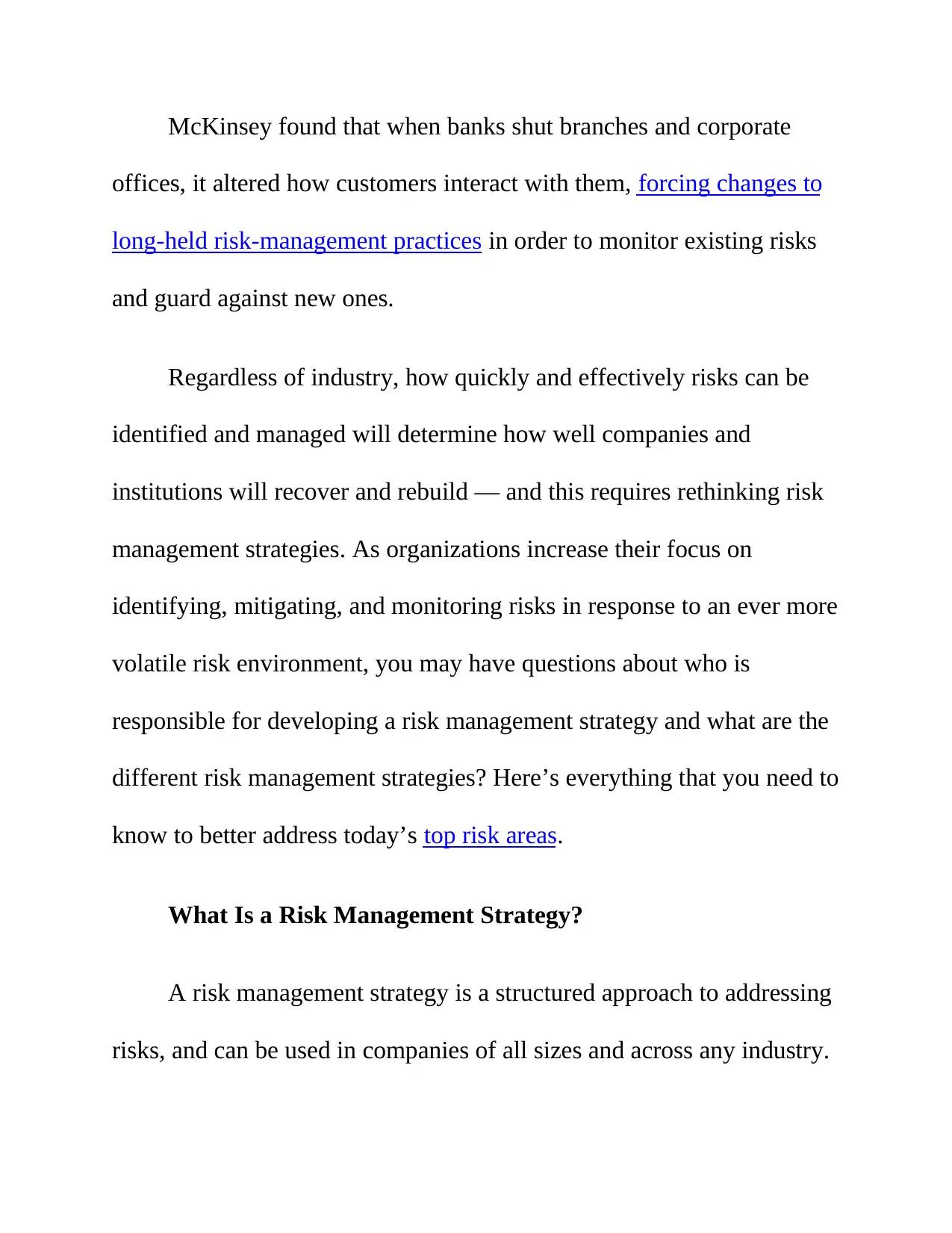
McKinsey found that when banks shut branches and corporate
offices, it altered how customers interact with them, forcing changes to
long-held risk-management practices in order to monitor existing risks
and guard against new ones.
Regardless of industry, how quickly and effectively risks can be
identified and managed will determine how well companies and
institutions will recover and rebuild — and this requires rethinking risk
management strategies. As organizations increase their focus on
identifying, mitigating, and monitoring risks in response to an ever more
volatile risk environment, you may have questions about who is
responsible for developing a risk management strategy and what are the
different risk management strategies? Here’s everything that you need to
know to better address today’s top risk areas.
What Is a Risk Management Strategy?
A risk management strategy is a structured approach to addressing
risks, and can be used in companies of all sizes and across any industry.
offices, it altered how customers interact with them, forcing changes to
long-held risk-management practices in order to monitor existing risks
and guard against new ones.
Regardless of industry, how quickly and effectively risks can be
identified and managed will determine how well companies and
institutions will recover and rebuild — and this requires rethinking risk
management strategies. As organizations increase their focus on
identifying, mitigating, and monitoring risks in response to an ever more
volatile risk environment, you may have questions about who is
responsible for developing a risk management strategy and what are the
different risk management strategies? Here’s everything that you need to
know to better address today’s top risk areas.
What Is a Risk Management Strategy?
A risk management strategy is a structured approach to addressing
risks, and can be used in companies of all sizes and across any industry.
Paraphrase This Document
Need a fresh take? Get an instant paraphrase of this document with our AI Paraphraser
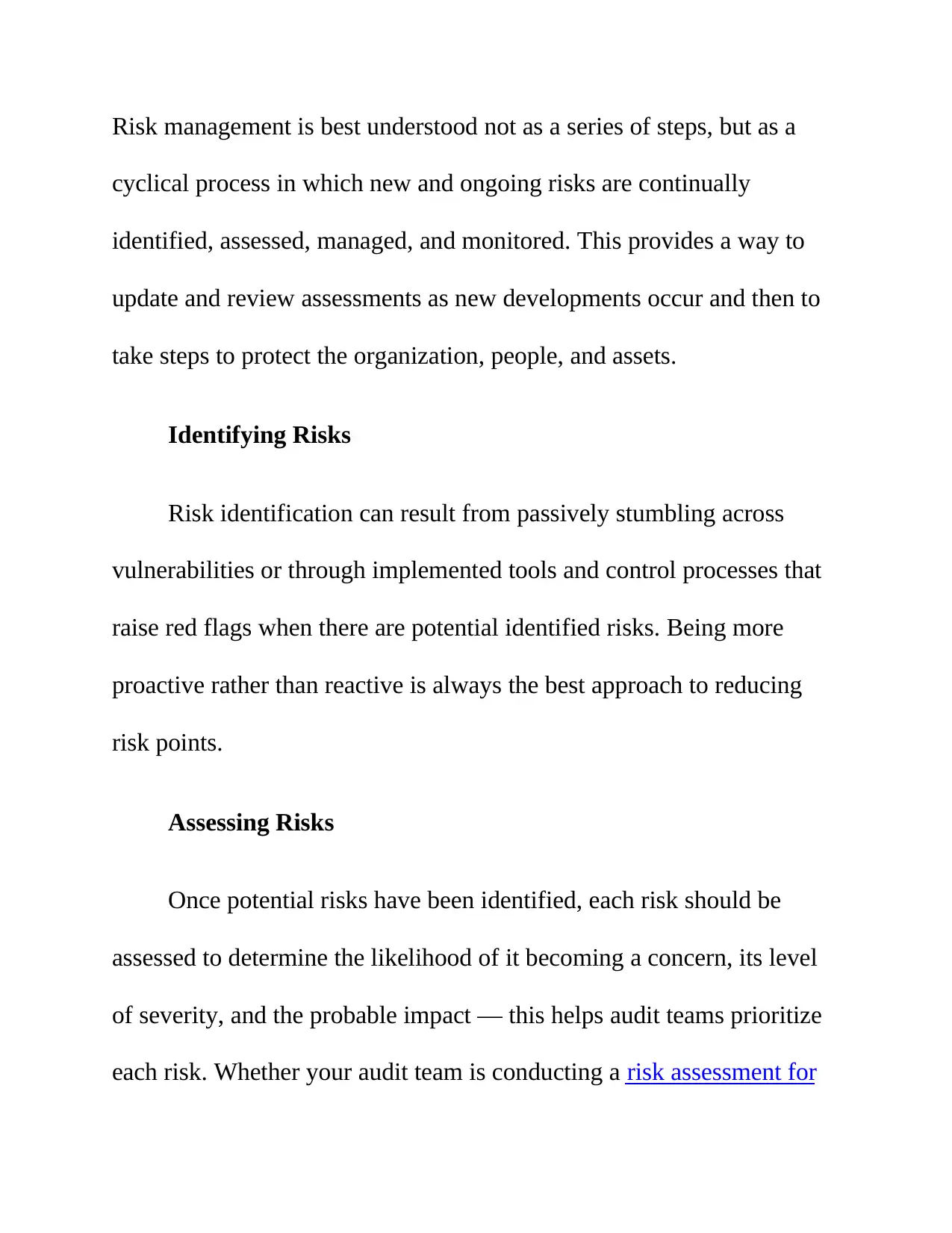
Risk management is best understood not as a series of steps, but as a
cyclical process in which new and ongoing risks are continually
identified, assessed, managed, and monitored. This provides a way to
update and review assessments as new developments occur and then to
take steps to protect the organization, people, and assets.
Identifying Risks
Risk identification can result from passively stumbling across
vulnerabilities or through implemented tools and control processes that
raise red flags when there are potential identified risks. Being more
proactive rather than reactive is always the best approach to reducing
risk points.
Assessing Risks
Once potential risks have been identified, each risk should be
assessed to determine the likelihood of it becoming a concern, its level
of severity, and the probable impact — this helps audit teams prioritize
each risk. Whether your audit team is conducting a risk assessment for
cyclical process in which new and ongoing risks are continually
identified, assessed, managed, and monitored. This provides a way to
update and review assessments as new developments occur and then to
take steps to protect the organization, people, and assets.
Identifying Risks
Risk identification can result from passively stumbling across
vulnerabilities or through implemented tools and control processes that
raise red flags when there are potential identified risks. Being more
proactive rather than reactive is always the best approach to reducing
risk points.
Assessing Risks
Once potential risks have been identified, each risk should be
assessed to determine the likelihood of it becoming a concern, its level
of severity, and the probable impact — this helps audit teams prioritize
each risk. Whether your audit team is conducting a risk assessment for
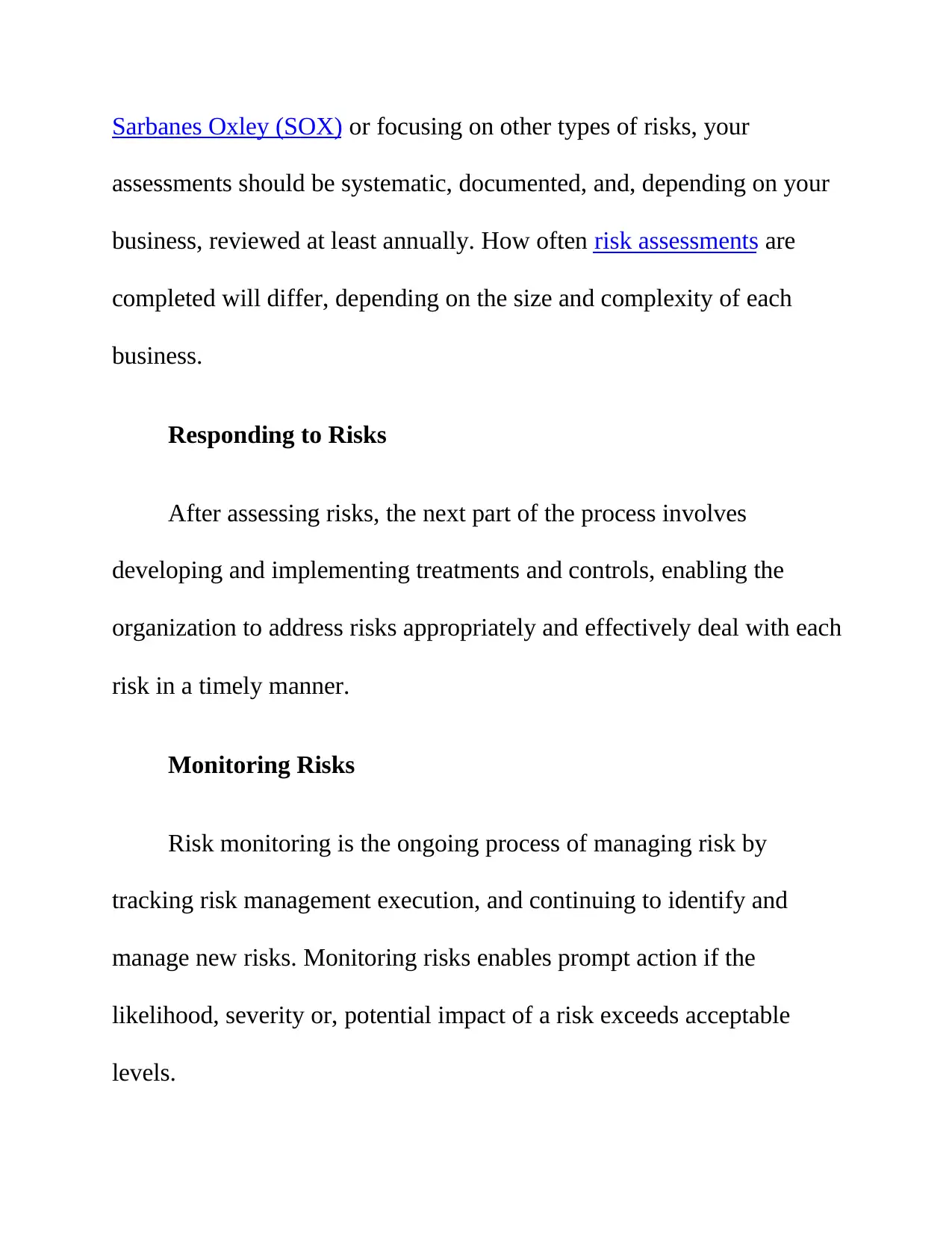
Sarbanes Oxley (SOX) or focusing on other types of risks, your
assessments should be systematic, documented, and, depending on your
business, reviewed at least annually. How often risk assessments are
completed will differ, depending on the size and complexity of each
business.
Responding to Risks
After assessing risks, the next part of the process involves
developing and implementing treatments and controls, enabling the
organization to address risks appropriately and effectively deal with each
risk in a timely manner.
Monitoring Risks
Risk monitoring is the ongoing process of managing risk by
tracking risk management execution, and continuing to identify and
manage new risks. Monitoring risks enables prompt action if the
likelihood, severity or, potential impact of a risk exceeds acceptable
levels.
assessments should be systematic, documented, and, depending on your
business, reviewed at least annually. How often risk assessments are
completed will differ, depending on the size and complexity of each
business.
Responding to Risks
After assessing risks, the next part of the process involves
developing and implementing treatments and controls, enabling the
organization to address risks appropriately and effectively deal with each
risk in a timely manner.
Monitoring Risks
Risk monitoring is the ongoing process of managing risk by
tracking risk management execution, and continuing to identify and
manage new risks. Monitoring risks enables prompt action if the
likelihood, severity or, potential impact of a risk exceeds acceptable
levels.
⊘ This is a preview!⊘
Do you want full access?
Subscribe today to unlock all pages.

Trusted by 1+ million students worldwide
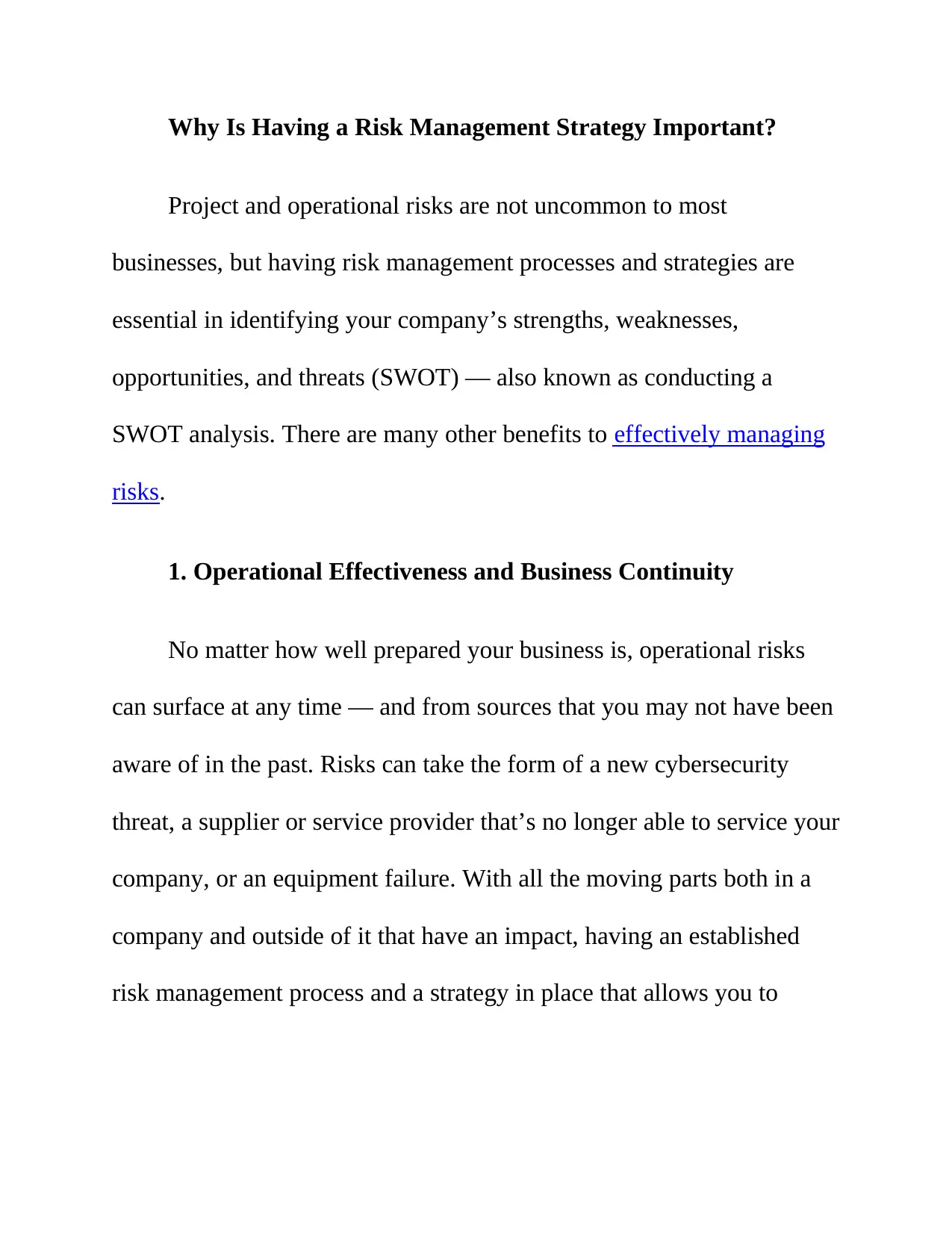
Why Is Having a Risk Management Strategy Important?
Project and operational risks are not uncommon to most
businesses, but having risk management processes and strategies are
essential in identifying your company’s strengths, weaknesses,
opportunities, and threats (SWOT) — also known as conducting a
SWOT analysis. There are many other benefits to effectively managing
risks.
1. Operational Effectiveness and Business Continuity
No matter how well prepared your business is, operational risks
can surface at any time — and from sources that you may not have been
aware of in the past. Risks can take the form of a new cybersecurity
threat, a supplier or service provider that’s no longer able to service your
company, or an equipment failure. With all the moving parts both in a
company and outside of it that have an impact, having an established
risk management process and a strategy in place that allows you to
Project and operational risks are not uncommon to most
businesses, but having risk management processes and strategies are
essential in identifying your company’s strengths, weaknesses,
opportunities, and threats (SWOT) — also known as conducting a
SWOT analysis. There are many other benefits to effectively managing
risks.
1. Operational Effectiveness and Business Continuity
No matter how well prepared your business is, operational risks
can surface at any time — and from sources that you may not have been
aware of in the past. Risks can take the form of a new cybersecurity
threat, a supplier or service provider that’s no longer able to service your
company, or an equipment failure. With all the moving parts both in a
company and outside of it that have an impact, having an established
risk management process and a strategy in place that allows you to
Paraphrase This Document
Need a fresh take? Get an instant paraphrase of this document with our AI Paraphraser
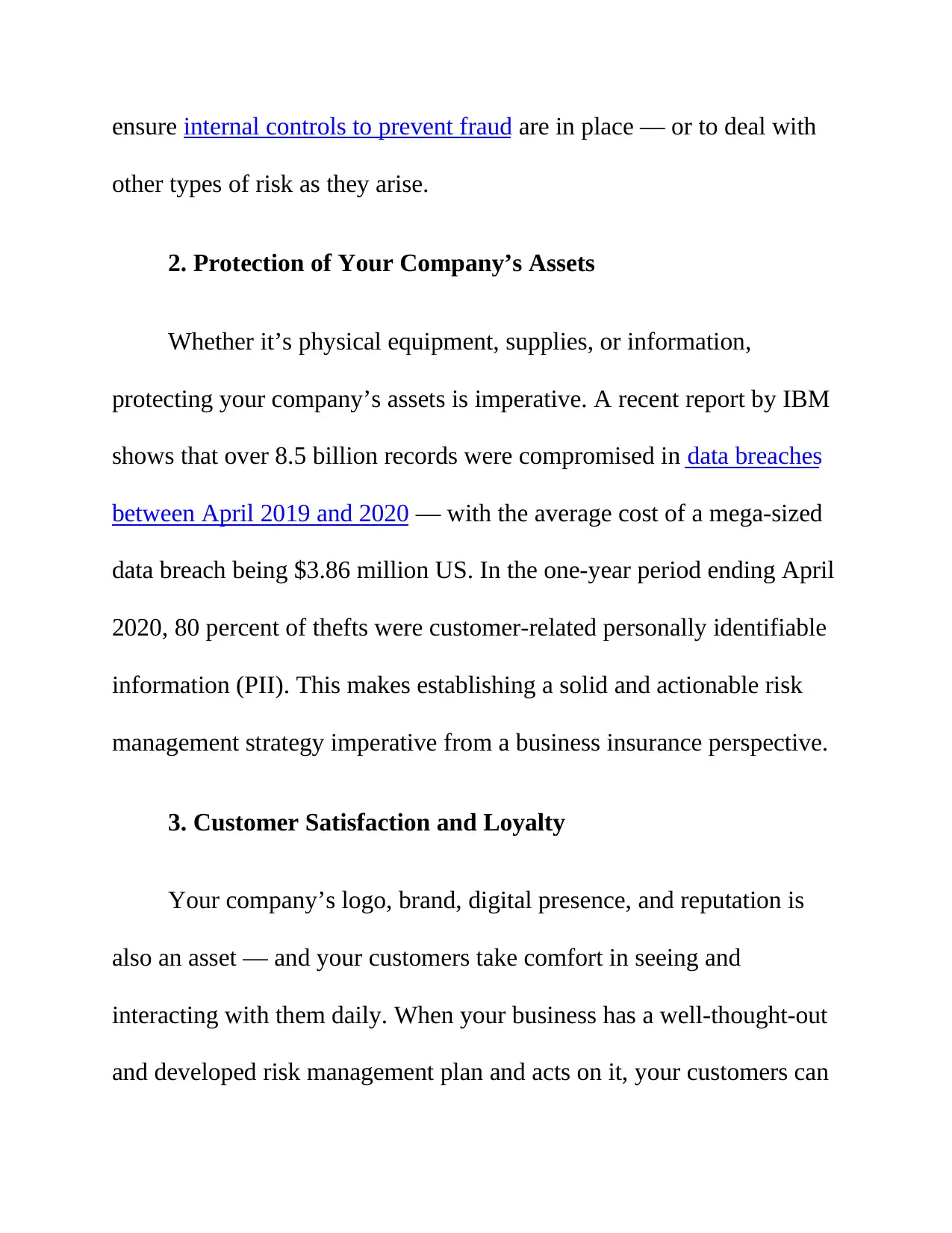
ensure internal controls to prevent fraud are in place — or to deal with
other types of risk as they arise.
2. Protection of Your Company’s Assets
Whether it’s physical equipment, supplies, or information,
protecting your company’s assets is imperative. A recent report by IBM
shows that over 8.5 billion records were compromised in data breaches
between April 2019 and 2020 — with the average cost of a mega-sized
data breach being $3.86 million US. In the one-year period ending April
2020, 80 percent of thefts were customer-related personally identifiable
information (PII). This makes establishing a solid and actionable risk
management strategy imperative from a business insurance perspective.
3. Customer Satisfaction and Loyalty
Your company’s logo, brand, digital presence, and reputation is
also an asset — and your customers take comfort in seeing and
interacting with them daily. When your business has a well-thought-out
and developed risk management plan and acts on it, your customers can
other types of risk as they arise.
2. Protection of Your Company’s Assets
Whether it’s physical equipment, supplies, or information,
protecting your company’s assets is imperative. A recent report by IBM
shows that over 8.5 billion records were compromised in data breaches
between April 2019 and 2020 — with the average cost of a mega-sized
data breach being $3.86 million US. In the one-year period ending April
2020, 80 percent of thefts were customer-related personally identifiable
information (PII). This makes establishing a solid and actionable risk
management strategy imperative from a business insurance perspective.
3. Customer Satisfaction and Loyalty
Your company’s logo, brand, digital presence, and reputation is
also an asset — and your customers take comfort in seeing and
interacting with them daily. When your business has a well-thought-out
and developed risk management plan and acts on it, your customers can
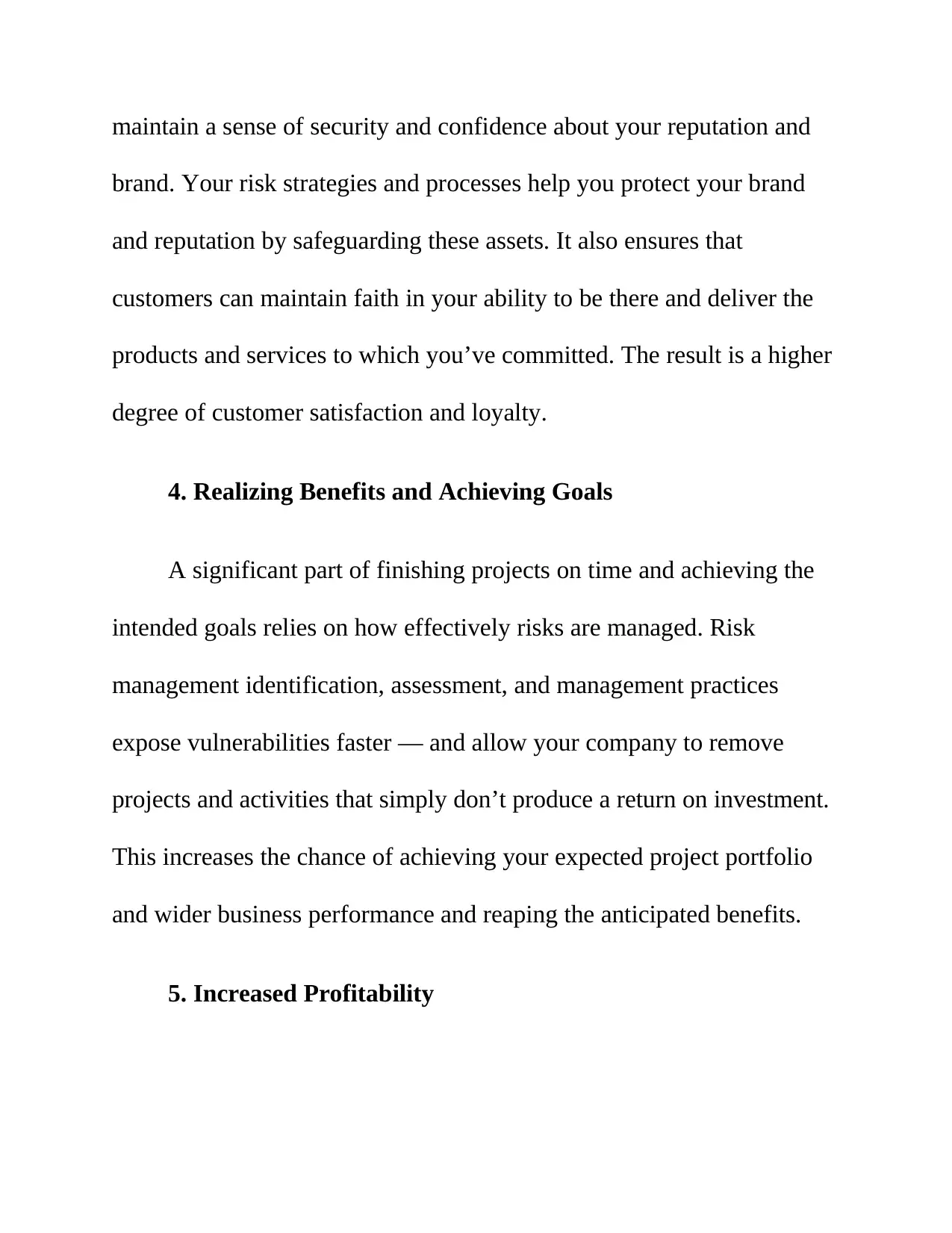
maintain a sense of security and confidence about your reputation and
brand. Your risk strategies and processes help you protect your brand
and reputation by safeguarding these assets. It also ensures that
customers can maintain faith in your ability to be there and deliver the
products and services to which you’ve committed. The result is a higher
degree of customer satisfaction and loyalty.
4. Realizing Benefits and Achieving Goals
A significant part of finishing projects on time and achieving the
intended goals relies on how effectively risks are managed. Risk
management identification, assessment, and management practices
expose vulnerabilities faster — and allow your company to remove
projects and activities that simply don’t produce a return on investment.
This increases the chance of achieving your expected project portfolio
and wider business performance and reaping the anticipated benefits.
5. Increased Profitability
brand. Your risk strategies and processes help you protect your brand
and reputation by safeguarding these assets. It also ensures that
customers can maintain faith in your ability to be there and deliver the
products and services to which you’ve committed. The result is a higher
degree of customer satisfaction and loyalty.
4. Realizing Benefits and Achieving Goals
A significant part of finishing projects on time and achieving the
intended goals relies on how effectively risks are managed. Risk
management identification, assessment, and management practices
expose vulnerabilities faster — and allow your company to remove
projects and activities that simply don’t produce a return on investment.
This increases the chance of achieving your expected project portfolio
and wider business performance and reaping the anticipated benefits.
5. Increased Profitability
⊘ This is a preview!⊘
Do you want full access?
Subscribe today to unlock all pages.

Trusted by 1+ million students worldwide
1 out of 42
Related Documents
Your All-in-One AI-Powered Toolkit for Academic Success.
+13062052269
info@desklib.com
Available 24*7 on WhatsApp / Email
![[object Object]](/_next/static/media/star-bottom.7253800d.svg)
Unlock your academic potential
Copyright © 2020–2025 A2Z Services. All Rights Reserved. Developed and managed by ZUCOL.





